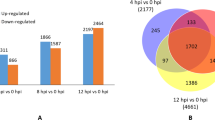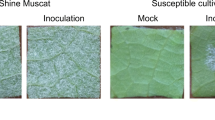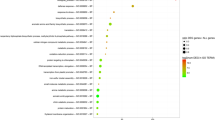Abstract
Viral diseases affect grapevine cultures without inducing any resistance response. Thus, these plants develop systemic diseases and are chronically infected. Molecular events associated with viral compatible infections responsible for disease establishment and symptoms development are poorly understood. In this study, we surveyed viral infection in grapevines at a transcriptional level. Gene expression in the Vitis vinifera red wine cultivars Carménère and Cabernet-Sauvignon naturally infected with GLRaV-3 were evaluated using a genome-wide expression profiling with the Vitis vinifera GeneChip® from Affymetrix. We describe numerous genes that are induced or repressed in viral infected grapevines leaves. Changes in gene expression involved a wide spectrum of biological functions, including processes of translation and protein targeting, metabolism, transport, and cell defense. Considering cellular localization, the membrane and endomembrane systems appeared with the highest number of induced genes, while chloroplastic genes were mostly repressed. As most induced genes associated with the membranous system are involved in transport, the possible effect of virus in this process is discussed. Responses of both cultivars are analyzed and the results are compared with published data from other species. This is the first study of global gene profiling in grapevine in response to viral infections using DNA microarray.





Similar content being viewed by others

References
Alzhanova DV, Napuli AJ, Creamer R, Dolja VV (2001) Cell-to-cell movement and assembly of a plant closterovirus: roles for the capsid proteins and Hsp70 homolog. EMBO J 20:6997–7007
Aparicio F, Thomas CL, Lederer C, Niu Y, Wang D, Maule A (2005) Virus induction of heat shock protein 70 reflects a general response to protein accumulation in the plant Cytosol. Plant Physiol 138:529–536
Aranda M, Maule A (1998) Virus-induced host gene shutoff in animals and plants. Virology 243:261–267
Aziz A, Poinnsot B, Daire X, Adrian M, Bezier A, Lambert B, Joubert JM, Pugin A (2003) Laminarin elicits defense response in grapevine and induces protection against Botrytis cinerea and Plasmopara viticola. Mol Plant-Microb Interact 16(12):1118–1128
Benjamini Y, Hochberg Y (1995) Controlling the false discovery rate: a practical and powerful approach to multiple testing. J R Stat Soc Ser B 57:289–300
Borgo M, Angelini E (2002) Influence of grapevine leaf roll (GLRaV3) on Merlot cv. grape production. Bull de l’OIV 859–860:611–623
Cakir B, Agasse A, Gaillard C, Saumonneau A, Delrot S, Atanassova R (2003) A grape ASR protein involved in sugar and abscicic acid signaling. Plant Cell 15:2165–2180
Chen MH, Citovsky V (2003) Systemic movement of a tobamovirus requires host cell pectin methylesterase. Plant J 35(3):386–392
Chen MH, Sheng J, Hind G, Handa AK, Citovsky V (2000) Interaction between the tobacco mosaic virus movement protein and host cell pectin methylesterases is required for viral cell-to-cell movement. EMBO J 19(5):913–920
Di Gaspero G, Cipriani G (2002) Resistance gene analogs are candidate markers for disease-resistance genes in grape (Vitis spp.) Theor Appl Genet 106(1):163–172
Durrant WE, Dong X (2004) Systemic acquired resistance. Annu Rev Phytopathol 42:185–209
Ehrenfeld N, Cañón P, Stange C, Medina C, Arce-Johnson P (2005) Tobamovirus coat protein CPCg induces an HR-like response in sensitive tobacco plants. Mol Cells 19:1–9
Fotopoulos V, Gilbert MJ, Pittman JK, Marvier AC, Buchanan AJ, Sauer N, Hall JL, Williams LE (2003) The monosaccharide transporter gene, AtSTP4, and the cell-wall invertase, Atbetafruct1, are induced in Arabidopsis during infection with the fungal biotroph Erysiphe cichoracearum. Plant Physiol 132:821–829
Garcia-Rodriguez S, Pozo MJ, Azcon-Aguilar C, Ferrol N (2005) Expression of a tomato sugar transporter is increased in leaves of mycorrhizal or phytophthora parasitica-infected plants. Mycorrhiza 15:489–496
Gautier L, Cope L, Bolstad B, Irizarry RA (2004) affy—analysis of Affymetrix GeneChip® data at the probe level. Bioinformatics 20(3):307–315
Golem S, Culver JN (2003) Tobacco mosaic virus induced alterations in the gene expression profile of Arabidopsis thaliana. Mol Plant-Microb Interact 16:681–688
Goes da Silva F, Iandolino A, Al-Kayal F, Bohlmann MC, Cushman MA, Lim H, Ergul A, Figueroa R, Kabuloglu EK, Osborne C, Rowe J, Tattersall E, Leslie A, Xu J, Baek J, Cramer GR, Cushman JC, Cook DR (2005) Characterizing the Grape Transcriptome. Analysis of expressed sequence tags from multiple Vitis species and development of a compendium of gene expression during berry development. Plant Physiol 19(2):574–597
Irizarry RA, Hobbs R, Collin R, Beazer-Barclay YD, Antonellis KJ, Scherf U, Speed TP (2003) Exploration, normalization, and summaries of high density oligonucleotide array probe level data. Biostatistics 4:249–264
Ishihara T, Sakurai N, Sekine KT, Hase H, Ikegami M, Shibata D, Takahashi H (2004) Comparative analysis of expressed sequenced tags in resistant and susceptible ecotypes of Arabidopsis thaliana infected with cucumber mosaic virus. Plant Cell Physiol 45:470–480
Itaya A, Matsuda Y, Gonzales R, Nelson RS, Ding B (2002) Potato spindle tuber viroid strains of different pathogenicity induces and suppresses expression of common and unique genes in infected tomato. Mol Plant-Microb Interact 15:990–999
Kerr MK, Martin M, Churchill GA (2000) Analysis of variance for gene expression microarray data. J Comp Biol 7(6):819–837
Lehto K, Tikkanen M, Hiriart JB, Paakkarinen V, Aro EM (2003) Depletion of the photosystem II core complex in mature tobacco leaves infected by the flavum strain of tobacco mosaic virus. Mol Plant-Microb Interact 16:1135–1144
Ling KS, Zhu HY, Gonsalves D (2004) Complete nucleotide sequence and genome organization of grapevine leafroll-associated virus 3, type member of the genus Ampelovirus. J Gen Virol 85:2099–2102
Lubkowitz M (2006) The OPT family functions in long distance peptide and metal transport in plants. Genet Eng (NY) 27:35–55
Mahalingam R, Gomez-Buitrago AM, Eckardt N, Shah N, Guevara-Garcia A, Day P, Raina R, Fedoroff NV (2003) Characterizing the stress/defense transcriptome of Arabidopsis. Genome Biol 4(3):R20
Martelli GP (1993) Graft-transmissible diseases of grapevines. In: Handbook for detection and diagnosis. FAO, Rome
Martelli GP, Agranovsky AA, Bar-Joseph M, Boscia D, Candresse T, Coutts RHA, Dolja VV, Falk BW, Gonsalves D, Jelkmann W, Karasev AV, Minafra A, Namba S, Vetten HJ, Wisler GC, Yoshikawa N (2002) The family Closteroviridae revised. Arch Virol 147(10):2039–2044
Maule A, Leh V, Ledrer C (2002) The dialog between viruses and host in compatible interactions. Curr Opin Plant Biol 5:279–284
Mayda E, Marques C, Conejero V, Vera P (2000) Expression of a pathogen-induced gene can be mimicked by auxin insensitivity. Mol Plant-Microb Interact 13(1):23–31
Minafra A, Hadidi A (1994) Sensitive detection of grapevine virus A, B or leaf roll associated III from viruliferous mealybugs and infected tissue by cDNA amplification. J Virol Methods 47:175–187
Mueller L, Goodman C, Silady R, Walbot V (2000) AN9, a petunia glutathione S-transferase required for anthocyanin sequestration, is a flavonoid-binding protein. Plant Physiol 123:1561–1570
O’Donnell PJ, Schmelz EA, Moussatche P, Lund ST, Jonnes JB, Klee HJ (2003) Susceptible to intolerance—a range of hormonal actions in a susceptible Arabidopsis pathogen response. Plant J 33(2):245–257
Ostergaard L, Petersen M, Mattsson O, Mundy J (2002) An Arabidopsis callose synthase. Plant Mol Biol 49:559–566
Padmanabhan MS, Goregaoker SP, Golem S, Shiferaw H, Culver JN (2005) Interaction of the tobacco mosaic virus replicase protein with the Aux/IAA protein PAP1/IAA26 is associated with disease development. J Virol 79(4):2549–2558
Park CJ, Shin R, Park JM, Lee GJ, You JS, Paek KH (2002) Induction of pepper cDNA encoding a lipid transfer protein during the resistance response to tobacco mosaic virus. Plant Mol Biol 48(3):243–254
Pennazio S, Roggero P (1996) Plant hormones and plant virus diseases. The auxins. New Microbiol 19(4):369–378
Pontier D, Gan S, Amasino RM, Roby D, Lam E (1999) Markers for hypersensitive response and senescence show distinct patterns of expression. Plant Mol Biol 39(6):1243–1255
Quirino BF, Noh YS, Himelblau E, Amasino RM (2000) Molecular aspects of leaf senescence. Trends Plant Sci 5:278–282
Simoes I, Faro C (2004) Structure and function of plant aspartic proteinases. Eur J Biochem 271(11):2067–2075
Singla-Pareek SL, Reddy MK, Sopory SK (2003) Genetic engineering of the glyoxalase pathway in tobacco leads to enhanced salinity tolerance. Proc Natl Acad Sci U S A 100(25):14672–14677
Smith CM, Rodríguez-Buey M, Karlsson J, Campbell M (2004)The response of the poplar transcriptome to wounding and subsequent infection by a viral pathogen. New Phytol 164:123–136
Sohal AK, Pallas JA, Jenkins GI (1999) The promoter of a Brassica napus lipid transfer protein gene is active in a range of tissues and stimulated by light and viral infection in transgenic Arabidopsis. Plant Mol Biol 41(1):75–87
Tomita Y, Mizuno T, Diez J, Naito S, Ahlquist P, Ishikawa M (2003) Mutation of host DnaJ homolog inhibits brome mosaic virus negative-strand RNA synthesis. J Virol 77(5):2990–2997
Vivier MA, Pretorius IS (2002) Genetically tailored grapevines for the wine industry. Trends Biotech 20:472–478
Wan J, Dunning FM, Bent AF (2002) Probing plant–pathogen interactions and downstream defense signaling using DNA microarrays. Funct Integr Genomics 2:259–273
Weaver LM, Gan S, Quirino B, Amasino RM (1998) A comparison of the expression patterns of several senescence-associated genes in response to stress and hormone treatment. Plant Mol Biol 37(3):455–469
Whitham S, Quan S, Chang HS, Cooper B, Estes B, Zhu T, Wang X, Hou YM (2003) Diverse RNA viruses elicit the expression of common sets of genes in susceptible Arabidopsis thaliana plants. Plant J 33:271–283
Acknowledgements
This work was supported by Chilean Genome Initiative FONDEF G02S1001 and INNOVA Bio-Bio Grant AL215L1.
Dr. Cramer acknowledges support from the National Science Foundation (NSF) Plant Genome (DBI-0217653) and the Nevada Agricultural Experiment Station, Publication no. 03066922. The Nevada Genomic Center acknowledges support from the NIH IdeA Network of Biomedical Research Excellence (INBRE, RR-03-008), NIH-NCRR Biomedical Research Infrastructure Network (P20 RR016464) and NSF EPSCoR (EPS-0132556) Integrated Approaches to Abiotic Stress Cluster.
Author information
Authors and Affiliations
Corresponding author
Electronic supplementary material
Below is the link to the electronic supplementary material.
Table S1
Change in gene expression level in Vitis vinifera cv. Carménère during infection with GLRaV-3. After data processing and analysis (for details, see Materials and methods) a group of genes with change in their absolute expression level value more than twofold was obtained. This list includes both up- and down-regulated genes (PDF 83 kb)
Table S2
Change in gene expression level in Vitis vinifera cv. Cabernet-Sauvignon during infection with GLRaV-3. After data processing and analysis (for details, see Materials and methods) a group of genes with change in their absolute expression level value more than twofold was obtained. This list includes both up- and down-regulated genes (PDF 116 kb)
Rights and permissions
About this article
Cite this article
Espinoza, C., Vega, A., Medina, C. et al. Gene expression associated with compatible viral diseases in grapevine cultivars. Funct Integr Genomics 7, 95–110 (2007). https://doi.org/10.1007/s10142-006-0031-6
Received:
Revised:
Accepted:
Published:
Issue Date:
DOI: https://doi.org/10.1007/s10142-006-0031-6



